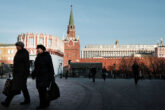June 14, 2024
NATO’s Missing Pillar
The Alliance Needs a More Powerful Europe
As war rages in Ukraine and the U.S. presidential campaign heats up, NATO leaders are grappling with how to prepare the alliance for all possible outcomes. The German and Danish defense ministers have warned that Russia could attack NATO allies “within five years.” Conflict could come sooner if Russia achieves a breakthrough on the battlefield in Ukraine. And by the end of the year, former U.S. President Donald Trump, who has urged Russian leaders to “do whatever the hell they want” to NATO members who “don’t pay up,” referring to the alliance’s spending target, could be the president-elect. Meanwhile, whoever occupies the White House will continue to shift U.S. resources to the Indo-Pacific. The United States’ force posture in Europe will recede. The only question is whether that happens gradually or suddenly.
Transatlantic security is built on two pillars: U.S. power and European power. Should the United States falter in its commitment to NATO or be stretched too thinly between theaters, Europe would bear the burden of protecting the continent. As of now, however, Europe is not prepared for that responsibility. Although European governments have been increasing their investments in defense and assistance to Ukraine, some European members of NATO still fall short of the alliance’s defense spending targets. The impressive amount of equipment and ammunition that European countries have given to Ukraine has also depleted some of their own weapons stocks.
It is commonly assumed that NATO was built on U.S. power, but in fact the commitment to collective security emerged in Europe first.
Strengthening the European pillar of NATO is the clear answer to the continent’s security problem. Yet for 25 years, the United States has been reluctant to support a larger European role within the alliance. Even as Washington urged its European allies to spend more on defense, U.S. leaders were loath to surrender the reins of transatlantic security. It is now time for that mindset to change. When allied leaders meet in Washington for NATO’s 75th anniversary summit in July, they should commit to fortifying European defense. Europe needs to invest more money to improve its military capabilities and combat power, and to get better at coordinating the efforts of individual countries. The United States must encourage such a transformation, not get in its way—and the European Union should help, too. Without a stronger European pillar of NATO, Russia will continue to threaten transatlantic security and the United States will be unable to focus its resources on China.
Read the full article from Foreign Affairs.
More from CNAS
-
Ukraine Negotiations: Prospects and Pitfalls of Peace
This week Brussels Sprouts breaks down the latest negotiations on Ukraine. American officials told reporters that they had resolved or closed gaps around 90 percent of their d...
By Andrea Kendall-Taylor & Jim Townsend
-
Can the Global Order Be Saved? Not Without Punishing Russia
The only way to succeed in the urgent task of achieving a just peace settlement, therefore, is radically reshaping Russia’s calculus....
By Nicholas Lokker
-
CNAS Insights | Russia Is Winning the Battle for Influence in Nigeria
Across Africa, Russia and its proxies are well known for providing security and extracting wealth. In the Sahel the Wagner Group, and subsequently the Russian Defense Ministry...
By Kate Johnston
-
Transatlantic Tensions in the New National Security Strategy
On December 4th, the Trump administration released its long-awaited national security strategy, sending another round of shock waves through the transatlantic community. The N...
By Andrea Kendall-Taylor & Jim Townsend




